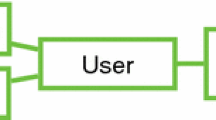Abstract
Combinatorial maps are nice data structures for modeling the topology of nD objects subdivided in cells (e.g., vertices, edges, faces, volumes, ...) by means of incidence and adjacency relationships between these cells. In particular, they can be used to model the topology of plane graphs. In this paper, we describe an algorithm, called mSpan, for extracting patterns which occur frequently in a database of maps. We experimentally compare mSpan with gSpan on a synthetic database of randomly generated 2D and 3D maps. We show that gSpan does not extract the same patterns, as it only considers adjacency relationships between cells. We also show that mSpan exhibits nicer scale-up properties when increasing map sizes or when decreasing frequency.
Access this chapter
Tax calculation will be finalised at checkout
Purchases are for personal use only
Preview
Unable to display preview. Download preview PDF.
Similar content being viewed by others
References
Braquelaire, J.-P., Brun, L.: Image segmentation with topological maps and inter-pixel representation 9(1), 62–79 (March 1998)
Brisson, E.: Representing geometric structures in d dimensions: topology and order. In: SCG, Saarbrücken, Germany, pp. 218–227 (1989)
Chi, Y., Muntz, R.R., Nijssen, S., Kok, J.N.: Frequent subtree mining - an overview. Fundam. Inf. 66, 161–198 (2004)
Cori, R.: Un code pour les graphes planaires et ses applications. In: Astérisque, Soc. Math. de France, Paris, France, vol. 27 (1975)
Damiand, G.: Topological model for 3d image representation: Definition and incremental extraction algorithm. CVIU 109(3), 260–289 (2008)
Damiand, G., Bertrand, Y., Fiorio, C.: Topological model for two-dimensional image representation: definition and optimal extraction algorithm. CVIU 93(2), 111–154 (2004)
Damiand, G., De La Higuera, C., Janodet, J.-C., Samuel, E., Solnon, C.: Polynomial Algorithm for Submap Isomorphism: Application to searching patterns in images. In: GbR. LNCS, pp. 102–112. Springer, Heidelberg (2009)
Damiand, G., Solnon, C., De La Higuera, C., Janodet, J.-C., Samuel, E.: Polynomial Algorithms for Subisomorphism of nD Open Combinatorial Maps. In: Computer Vision and Image Understanding (CVIU) (December 2011)
Edmonds, J.: A combinatorial representation for polyhedral surfaces. Notices of the American Mathematical Society 7 (1960)
Gosselin, S., Damiand, G., Solnon, C.: Efficient search of combinatorial maps using signatures. Theoretical Computer Science 412(15), 1392–1405 (2011); Theoretical Computer Science Issues in Image Analysis and Processing
Horvath, T., Ramon, J., Wrobel, S.: Frequent subgraph mining in outerplanar graphs. In: KDD 2006, pp. 197–206 (2006)
Jacques, A.: Constellations et graphes topologiques. Combinatorial Theory and Applications 2, 657–673 (1970)
Kuramochi, M., Karypis, G.: Frequent subgraph discovery. In: IEEE International Conference on Data Mining, vol. 0, p. 313 (2001)
Lienhardt, P.: Subdivision of n-dimensional spaces and n-dimensional generalized maps. In: SCG, Saarbrücken, Germany, pp. 228–236 (1989)
Lienhardt, P.: Topological models for boundary representation: a comparison with n-dimensional generalized maps. Computer-Aided Design 23(1), 59–82 (1991)
Lienhardt, P.: N-dimensional generalized combinatorial maps and cellular quasi-manifolds. IJCGA 4(3), 275–324 (1994)
Poudret, M., Arnould, A., Bertrand, Y., Lienhardt, P.: Cartes combinatoires ouvertes. Research Notes 2007-1, Laboratoire SIC E.A. 4103 (October 2007)
Salzberg, S.L.: C4.5: Programs for machine learning by j. ross quinlan. In: Machine Learning 1994, vol. 16, pp. 235–240. Morgan Kaufmann Publishers, Inc., San Francisco (1993), doi:10.1007/BF00993309
Tutte, W.T.: A census of planar maps. Canad. J. Math. 15, 249–271 (1963)
Yan, X., Han, J.: gspan: Graph-based substructure pattern mining. In: Proceedings of the 2002 IEEE International Conference on Data Mining, ICDM 2002, pages 721. IEEE Computer Society, Washington, DC (2002)
Author information
Authors and Affiliations
Editor information
Editors and Affiliations
Rights and permissions
Copyright information
© 2011 Springer-Verlag Berlin Heidelberg
About this paper
Cite this paper
Gosselin, S., Damiand, G., Solnon, C. (2011). Frequent Submap Discovery. In: Giancarlo, R., Manzini, G. (eds) Combinatorial Pattern Matching. CPM 2011. Lecture Notes in Computer Science, vol 6661. Springer, Berlin, Heidelberg. https://doi.org/10.1007/978-3-642-21458-5_36
Download citation
DOI: https://doi.org/10.1007/978-3-642-21458-5_36
Publisher Name: Springer, Berlin, Heidelberg
Print ISBN: 978-3-642-21457-8
Online ISBN: 978-3-642-21458-5
eBook Packages: Computer ScienceComputer Science (R0)




